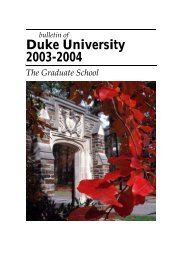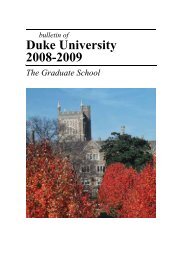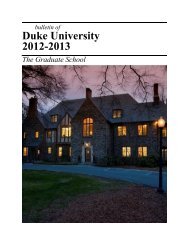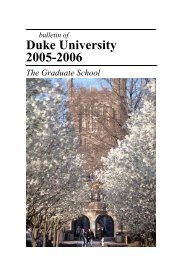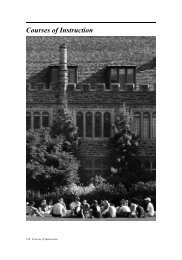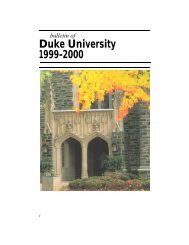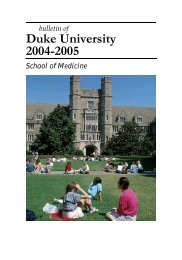Duke University 2009-2010 - Office of the Registrar - Duke University
Duke University 2009-2010 - Office of the Registrar - Duke University
Duke University 2009-2010 - Office of the Registrar - Duke University
Create successful ePaper yourself
Turn your PDF publications into a flip-book with our unique Google optimized e-Paper software.
way at <strong>the</strong> laboratory. The staff <strong>of</strong> <strong>the</strong> laboratory is available for consultation and participation in seminars.<br />
Arrangements may be made for students to conduct certain aspects <strong>of</strong> <strong>the</strong>ir research at <strong>the</strong> laboratory.<br />
Marine Laboratory. The <strong>Duke</strong> <strong>University</strong> Marine Laboratory (DUML) <strong>of</strong> <strong>the</strong> Nicholas school <strong>of</strong> <strong>the</strong> Environment<br />
and Earth Sciences is an educational and research facility. DUML is located on Pivers Island within <strong>the</strong> Outer Banks,<br />
adjacent to <strong>the</strong> historic seacoast town <strong>of</strong> Beaufort, North Carolina, with direct access to <strong>the</strong> Atlantic Ocean, Cape<br />
Lookout National Seashore Park, estuaries, sand beaches, wetlands, and coastal forests. The area provides an excellent<br />
opportunity for teaching and research at <strong>the</strong> undergraduate, masters, and doctoral levels. There are approximately 30<br />
masters and 20 resident doctoral students. (For additional information concerning <strong>the</strong> MA, MS, and PhD graduate<br />
programs refer to <strong>the</strong> section ''Courses and Academic Programs'' in this bulletin and for <strong>the</strong> MEM graduate program refer<br />
to <strong>the</strong> current Bulletin <strong>of</strong> <strong>Duke</strong> <strong>University</strong>: Nicholas School <strong>of</strong> <strong>the</strong> Environment and Earth Sciences.) The Marine<br />
Laboratory accommodates nearly 3,700 visitors per year. The physical plant consists <strong>of</strong> 23 buildings including five<br />
research buildings, six dormitories, a dining hall, classroom laboratories and a maintenance complex. Research from<br />
<strong>the</strong> molecular to <strong>the</strong> population level is supported at <strong>the</strong> Marine Laboratory. DUML operates <strong>the</strong> R/V Susan Hudson,<br />
a 57-foot fully equipped coastal oceans research vessel with <strong>the</strong> capacity to perform small-scale biological, chemical,<br />
geological, and physical oceanography. DUML is also <strong>the</strong> home port for <strong>the</strong> R/V Cape Hatteras, a 135-foot<br />
oceanographic research vessel operated for <strong>the</strong> NSF by <strong>the</strong> <strong>Duke</strong>/<strong>University</strong> <strong>of</strong> North Carolina Oceanographic<br />
Consortium.<br />
For information concerning teaching and research space, write to <strong>the</strong> Auxiliaries and Administrative Services<br />
<strong>Office</strong>, <strong>Duke</strong> <strong>University</strong> Marine Laboratory, 135 <strong>Duke</strong> Marine Lab Road, Beaufort, North Carolina 28516-9721;<br />
telephone 252/504-7652 or e-mail: dominick.brugnolotti@duke.edu.<br />
Lemur Center. The <strong>Duke</strong> Lemur Center is located in <strong>Duke</strong> Forest about two miles from <strong>the</strong> main campus. It is <strong>the</strong><br />
world’s only facility devoted entirely to <strong>the</strong> care, conservation, and study <strong>of</strong> lemurs. The colony is composed <strong>of</strong><br />
approximately 250 animals from more than twenty named taxa. The lemurs, and <strong>the</strong>ir closest relatives, <strong>the</strong> lorises, are<br />
housed in spacious indoor and outdoor facilities. In <strong>the</strong> summer months in particular, numerous lemurs "free range" in<br />
large tracts <strong>of</strong> open area within <strong>Duke</strong> Forest, providing a unique opportunity for investigators and students to study lemur<br />
behavior in a semi-natural setting. The Center also houses frozen, preserved, and fossil primate collections for study.<br />
All collections are utilized by students and faculty from a wide variety <strong>of</strong> <strong>Duke</strong> departments, as well as by scholars from<br />
o<strong>the</strong>r national and international institutions. Graduate students wishing to conduct research at <strong>the</strong> Center should<br />
indentify this interest to <strong>the</strong> director <strong>of</strong> graduate studies for <strong>the</strong> department to which <strong>the</strong>y are applying. For information<br />
pertaining to <strong>the</strong> use <strong>of</strong> <strong>the</strong> Lemur Center, graduate studies, or availability <strong>of</strong> research space, write to Dr. Sarah Zehr,<br />
sz19@duke.edu, Research Manager, <strong>Duke</strong> Lemur Center, 3705 Erwin Road, Durham, North Carolina 27705.<br />
Chemistry Laboratories. In 2007, <strong>the</strong> Department <strong>of</strong> Chemistry moved to <strong>the</strong> French Family Science Center, a<br />
state <strong>of</strong> <strong>the</strong> art research facility donated by Bill and Melinda Gates. This building houses not only <strong>the</strong> entire Chemistry<br />
Department, but also Biological Sciences, and a portion <strong>of</strong> <strong>the</strong> Physics Department and research labs. The building<br />
contains 275,000 square feet <strong>of</strong> total area, with additional research space in <strong>the</strong> Levine Science Research Center to<br />
accommodate chemistry at <strong>the</strong> biology interface. This well-equipped chemical laboratory provides conditions<br />
conducive to research in many areas <strong>of</strong> current interest. Major shared instruments, including those for nuclear magnetic<br />
resonance and mass spectrometry, are housed in <strong>the</strong> departmental instrumentation facility, along with optical and o<strong>the</strong>r<br />
instrumentation, including FTIR, UVVIS, and fluorescence spectrometers. A wide array <strong>of</strong> more specialized instrumentation<br />
is available in <strong>the</strong> various research laboratories, from ultrafast laser systems to atomic force microscopes to<br />
automated solid-phase syn<strong>the</strong>sizers. O<strong>the</strong>r major facilities on campus include <strong>the</strong> Free Electron Laser Laboratory and<br />
<strong>the</strong> <strong>University</strong> NMR Center, which maintains several ultra high field NMR instruments. A broad range <strong>of</strong> instrumentation<br />
for biological and materials science applications is accessible in <strong>the</strong> Medical Center and School <strong>of</strong> Engineering,<br />
with additional facilities available at <strong>the</strong> neighboring universities and in Research Triangle Park, including those for xray<br />
diffraction and structure determination.<br />
Computing facilities in Chemistry include SGI and Redhat Linux workstations, Beowulf clusters, and clusters <strong>of</strong><br />
PC’s associated with <strong>the</strong> teaching laboratories. The department is linked to <strong>the</strong> university's high speed fiber optic<br />
network and to <strong>the</strong> university’s high performance shared computing cluster. This building is primarily a research facility,<br />
and <strong>the</strong> majority <strong>of</strong> space is dedicated to research and teaching labs. In addition, <strong>the</strong> department has state-<strong>of</strong>-<strong>the</strong>-art<br />
computer/video projection systems in its lecture hall and conference rooms and wireless networking for incorporation<br />
<strong>of</strong> <strong>the</strong> latest computational research tools into <strong>the</strong> undergraduate chemistry curriculum.<br />
Physics Laboratories. The Physics Building houses research and instruction in <strong>the</strong> Departments <strong>of</strong> Physics and<br />
Ma<strong>the</strong>matics. Additional space is provided by <strong>the</strong> adjacent Nuclear Building (TUNL) and French Family Sciences Free<br />
Electron Laser (FEL) Laboratory Buildings. Graduate students conducting research in <strong>the</strong>se buildings usually have <strong>the</strong>ir<br />
<strong>of</strong>fices <strong>the</strong>re.<br />
About half <strong>of</strong> <strong>the</strong> Physics space is devoted to research laboratories for <strong>the</strong> department's programs. Special<br />
equipment includes: ultrafast, high power, short wavelength, and far-infrared lasers; a 1 GeV linear accelerator and<br />
high current electron storage ring driving an ultraviolet to s<strong>of</strong>t X-ray FEL (this facility is used, among o<strong>the</strong>r things, to<br />
produce a high-intensity gamma-ray source known as <strong>the</strong> HIGS project); a high-resolution 4 MeV Van de Graaff<br />
accelerator; a 20 MeV tandem Van de Graaff accelerator with polarized source and cryogenically-cooled polarized<br />
Resources for Study 239



